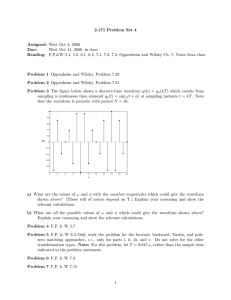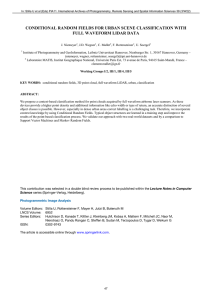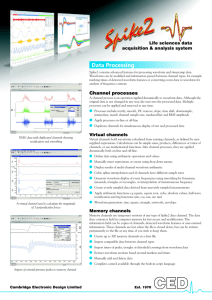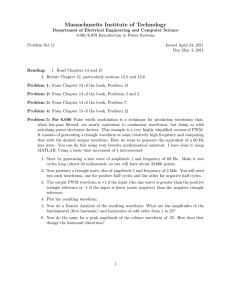Plethysmographic Waveform Introduction Methods
advertisement
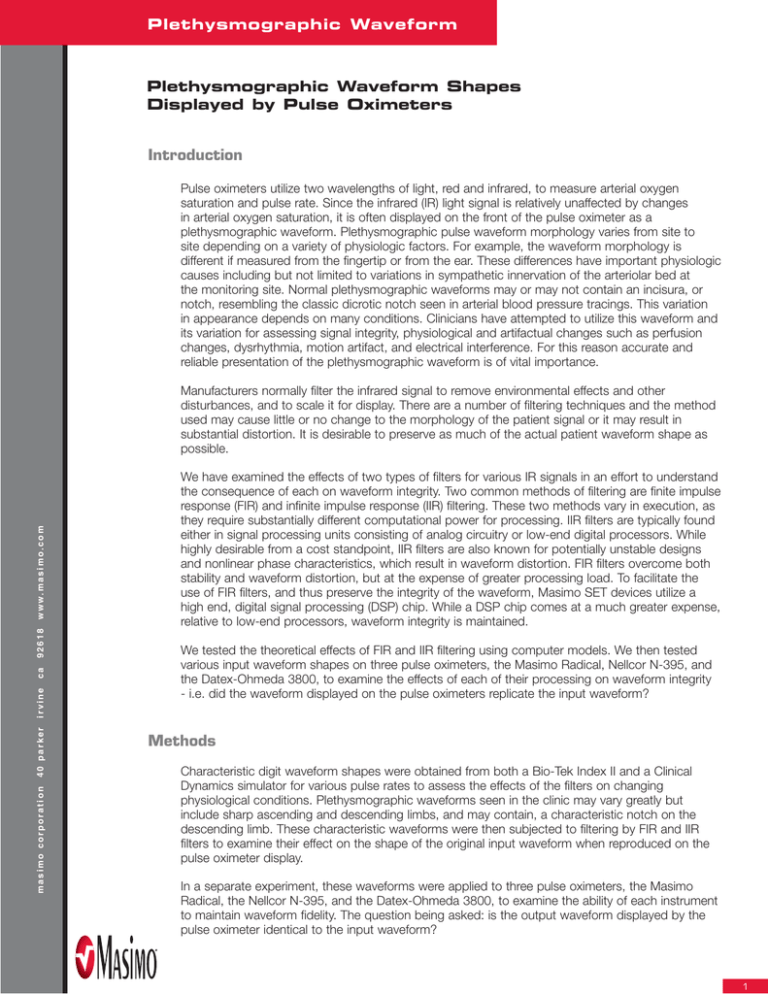
Plethysmographic Waveform Plethysmographic Waveform Shapes Displayed by Pulse Oximeters Introduction Pulse oximeters utilize two wavelengths of light, red and infrared, to measure arterial oxygen saturation and pulse rate. Since the infrared (IR) light signal is relatively unaffected by changes in arterial oxygen saturation, it is often displayed on the front of the pulse oximeter as a plethysmographic waveform. Plethysmographic pulse waveform morphology varies from site to site depending on a variety of physiologic factors. For example, the waveform morphology is different if measured from the fingertip or from the ear. These differences have important physiologic causes including but not limited to variations in sympathetic innervation of the arteriolar bed at the monitoring site. Normal plethysmographic waveforms may or may not contain an incisura, or notch, resembling the classic dicrotic notch seen in arterial blood pressure tracings. This variation in appearance depends on many conditions. Clinicians have attempted to utilize this waveform and its variation for assessing signal integrity, physiological and artifactual changes such as perfusion changes, dysrhythmia, motion artifact, and electrical interference. For this reason accurate and reliable presentation of the plethysmographic waveform is of vital importance. masimo corporation 40 parker irvine ca 92618 w w w. m a s i m o . c o m Manufacturers normally filter the infrared signal to remove environmental effects and other disturbances, and to scale it for display. There are a number of filtering techniques and the method used may cause little or no change to the morphology of the patient signal or it may result in substantial distortion. It is desirable to preserve as much of the actual patient waveform shape as possible. We have examined the effects of two types of filters for various IR signals in an effort to understand the consequence of each on waveform integrity. Two common methods of filtering are finite impulse response (FIR) and infinite impulse response (IIR) filtering. These two methods vary in execution, as they require substantially different computational power for processing. IIR filters are typically found either in signal processing units consisting of analog circuitry or low-end digital processors. While highly desirable from a cost standpoint, IIR filters are also known for potentially unstable designs and nonlinear phase characteristics, which result in waveform distortion. FIR filters overcome both stability and waveform distortion, but at the expense of greater processing load. To facilitate the use of FIR filters, and thus preserve the integrity of the waveform, Masimo SET devices utilize a high end, digital signal processing (DSP) chip. While a DSP chip comes at a much greater expense, relative to low-end processors, waveform integrity is maintained. We tested the theoretical effects of FIR and IIR filtering using computer models. We then tested various input waveform shapes on three pulse oximeters, the Masimo Radical, Nellcor N-395, and the Datex-Ohmeda 3800, to examine the effects of each of their processing on waveform integrity - i.e. did the waveform displayed on the pulse oximeters replicate the input waveform? Methods Characteristic digit waveform shapes were obtained from both a Bio-Tek Index II and a Clinical Dynamics simulator for various pulse rates to assess the effects of the filters on changing physiological conditions. Plethysmographic waveforms seen in the clinic may vary greatly but include sharp ascending and descending limbs, and may contain, a characteristic notch on the descending limb. These characteristic waveforms were then subjected to filtering by FIR and IIR filters to examine their effect on the shape of the original input waveform when reproduced on the pulse oximeter display. In a separate experiment, these waveforms were applied to three pulse oximeters, the Masimo Radical, the Nellcor N-395, and the Datex-Ohmeda 3800, to examine the ability of each instrument to maintain waveform fidelity. The question being asked: is the output waveform displayed by the pulse oximeter identical to the input waveform? 1 Plethysmographic Waveform Computer model Several waveform shapes were obtained from the Bio-Tek Index II and the Clinical Dynamics Smart Sat simulators. These shapes are typically seen in the clinical environment. The waveform shapes were then subjected to both FIR and IIR filtering on a personal computer. The results of these tests are depicted in Figures 1-4. Notch Test 0 1 2 3 4 5 6 7 8 9 10 time i Time (Second s) In pu t W av efo rm FIR Filter IIR Filter Zero Level fo r In p u t W av efo rm Zero Level fo r FIR Filter Ou tp u t Zero Level fo r IIR Ou tp u t masimo corporation 40 parker irvine ca 92618 w w w. m a s i m o . c o m Figure 1. FIR and IIR Filter Performance for a Waveform with Notch Input Figure 1 shows that the IIR filter causes distortion in the waveform. The notch is below midline, the descending limb is elongated (above the notch), and the descending limb (below the notch) is curved. technical bulletin R amp Test 0 1 2 3 4 5 6 7 8 9 10 time i Time (Second s) In pu t W av efo rm FIR Filter IIR Filter Zero Level fo r In p u t W av efo rm Zero Level fo r FIR Filter Ou tp u t Zero Level fo r IIR Ou tp u t Figure 2. FIR and IIR Filter Performance for a Ramp Input Figure 2 shows that the IIR filter causes distortion to the input waveform. The sharp, straight descending limb on the input signal is preserved with the FIR filter. In contrast, the IIR filter causes a curvilinear descending limb, which deviates greatly from the actual input waveform. Lo w Heart R ate Test 0 1 2 3 4 5 6 7 8 9 10 time i Time (Second s) In pu t W av efo rm FIR Filter IIR Filter Zero Level fo r In p u t W av efo rm Zero Level fo r FIR Filter Ou tp u t Zero Level fo r IIR Ou tp u t Figure 3. FIR and IIR Filter on a Low Heart Rate Input Figure 3 shows that the IIR filter causes distortion in the waveform. The notch is below midline, the descending limb is elongated (above the notch), and the descending limb (below the notch) is shortened and curved. In marked contrast, the FIR filter preserves the waveform integrity. 3 Plethysmographic Waveform Asysto le Test 0 1 2 3 4 5 6 7 8 9 10 time i Time (Second s) In pu t W av efo rm FIR Filter IIR Filter Zero Level fo r In p u t W av efo rm Zero Level fo r FIR Filter Ou tp u t Zero Level fo r IIR Ou tp u t Figure 4. FIR and IIR Filter Performance for an Asystole Input masimo corporation 40 parker irvine ca 92618 w w w. m a s i m o . c o m Figure 4 demonstrates the delays associated with the different types of filtering. While the IIR filter distorts the waveform, it appears almost in sync with the input waveform. In contrast, the increased integrity of the waveform with the FIR filter comes at the cost of a slight delay in waveform appearance. The four figures show that the processing performed by the FIR filter maintains the integrity of the input waveform. However, due to the increased computational requirements of the FIR filter the resultant waveform is delayed slightly in time. The IIR filtering causes marked distortion of the waveform with little delay in waveform appearance. Conclusions The processing used by pulse oximeters in their plethysmographic waveform generation may have an effect on the integrity of the waveform and/or its temporal display. As shown above, the IIR filter clearly causes marked distortion of the shape of the waveform with a minor delay in the displayed waveform appearing on the pulse oximeter screen. In contrast, the FIR filter with only a slight time increase to display the waveform, maintains the true shape of the waveform. technical bulletin Waveforms Displayed by Pulse Oximeter Figure 5. This depicts an input waveform at 70 bpm. Notice sharp ascending and descending limbs. Figure 6. Photo of waveform at 70 bpm displayed by Masimo Radical in response to input signals shown in figure 5. Notice that the waveform integrity is maintained. Figure 7. Photo of waveform at 70 bpm displayed by Nellcor N-395 in response to input signals shown in figure 5. Notice that the waveform is distorted and shows a curvature, which is not present in the input signal. Figure 8. Photo of waveform at 70 bpm displayed by Datex-Ohmeda 3800 in response to input signals shown in figure 5. Notice that the waveform is distorted and shows a curvature, which is not present in the input signal. 5 Plethysmographic Waveform Waveforms Displayed by Pulse Oximeter Figure 9. This depicts an input waveform at 72 bpm with notch at mid level of descending limb. Figure 11. Photo of notched waveform at 72 bpm displayed by Nellcor N-395 in response to input signals shown in figure 9. Notice the distortion in waveform and the notch well below midline. masimo corporation 40 parker irvine ca 92618 w w w. m a s i m o . c o m Figure 10. Photo of notched waveform at 72 bpm displayed by Masimo Radical in response to input signals shown in figure 9. Notice the notch appears at mid level and waveform integrity is excellent. Figure 12. Photo of notched waveform at 72 bpm as displayed by Datex-Ohmeda 3800 in response to input shown in figure 9. Notice the distortion in waveform and the notch well below midline. technical bulletin Waveforms Displayed by Pulse Oximeter Figure 13. This input waveform at 45 bpm with notch at mid level of descending limb. Figure 14. Photo of notched waveforms at 45 bpm as displayed by Masimo Radical in response to input signal shown in figure 13. Notice that the waveform integrity is preserved. Figure 15. Photo of notched waveform at 45 bpm as displayed by Nellcor N-395 in response to input signal shown in figure 13. Notice that the waveform is distorted and the notch is well below midline. Figure 16. Photo of notched waveform at 45 bpm as displayed by Datex-Ohmeda 3800 in response to input signal shown in figure 13. Notice that the waveform is distorted and the notch is well below midline. 7 ©2008 Masimo Corporation. All rights reserved. Masimo, Radical, SET, ,and Signal Extraction Technology are registered trademarks of Masimo Corporation. All rights reserved. All other products are trademarks of their respective owners. 7396-3618B-0108 Masimo Corporation 40 Parker Irvine, California 92618 Tel 949-297-7000 Fax 949-297-7001 www.masimo.com
